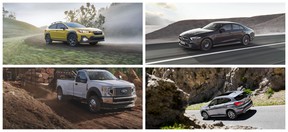Confused by car terms? We're here to help you decipher them
What determines an SUV, a crossover, a compact, a heavy-duty, and more?

Article content
You’re looking to buy a vehicle, so do you want a compact, midsize or full-size? A coupe, a crossover, sport-utility, or maybe a sports- activity?
Advertisement
Article content
There are a lot of terms, and sometimes it depends on what the manufacturer decides to call it. We’ll translate the terms to help you determine what it is you want to drive.
By the numbers
An automaker can call its vehicle pretty much whatever it wants, but there are classifications for fuel economy figures, determined by Natural Resources Canada (NRCan). This lets the agency compare equivalently-sized vehicles for the best or worst fuel economy.

Cars are rated by NRCan by their interior volume, from mini-compact (fewer than 2,405 litres) through subcompact, compact, midsize, and full-size, which is 3,400 litres or larger. Two-seaters and station wagons get their own ratings. SUVs are considered “light trucks,” and so are measured by their gross vehicle weight (its weight plus the maximum weight of passengers and cargo it can carry), as pickup trucks are. They’re divided into just two categories, with “small” SUV at 2,722 kg or lighter; and “standard,” from 2,722 to 4,536 kg. Any SUV heavier than that is exempt from testing.
Advertisement
Article content
Turning the wheels
Front-wheel drive, or FWD, means the front wheels are powered. Rear-wheel drive, or RWD, means it’s the back ones.
All-wheel drive (AWD) means power to both axles, as does four-wheel drive (4WD or 4×4), but the difference isn’t always clear. Usually, AWD indicates an automatic system that you don’t have to engage, while you switch a 4WD into four-wheel when needed, such as on a pickup truck. That said, some automakers may label an AWD system as 4WD, especially if they want to make the vehicle sound more off-road rugged. Know which kind you’re getting before you buy.
Door determination
Those of us at Driving.ca think a sedan is a four-door, and a coupe is a two-door. But some automakers design a four-door with a raked roof and call it a coupe, or perhaps “four-door coupe.”
Advertisement
Article content

And what about a “five-door”? That’s what some automakers call their hatchbacks, counting the hatch as a door. Some have used “three-door” to describe a two-door hatchback – and then there was the Hyundai Veloster, with three real doors, and it was called a coupe.
Sporty utility
SUV stands for sport utility vehicle, although not all of them are sporty, and some aren’t even all that utilitarian (but at least they’re all vehicles). They’re usually divided by size, and we have some general examples of how you may hear these vehicles described:
- Subcompact SUV: Toyota C-HR, Mazda CX-3, Honda HR-V
- Compact SUV: Hyundai Tucson, Nissan Rogue, Ford Escape
- Midsize SUV: Subaru Ascent, Kia Sorento, Lexus RX
- Full-size SUV: Chevrolet Suburan, BMW X7, Mercedes-Benz GLS
Advertisement
Article content
Note that we say general examples, because it can be tricky. Most people classify them by their physical size – but there’s no standard measurement for each category. NRCan actually considers the C-HR, CX-3, and HR-V to be cars, for the purpose of fuel rating, but on their websites, their manufacturers list them along with other SUVs.
A different SUV?
Sometimes, instead of SUV, you’ll see SAV. BMW uses it to mean Sports Activity Vehicle, while Hyundai calls its new Santa Cruz pickup a Sport Adventure Vehicle. It’s just a marketing deviation from the more-familiar SUV designation.
Advertisement
Article content
How many rows?
If an SUV is advertised as a three-row, then depending on how the seats are configured, it can hold six, seven, or eight people. “Captain’s chairs” means a second row of two separate seats, rather than a three-passenger bench seat. Most three-row SUVs are midsize or full-size.
The minivan
Their popularity has waned, but minivans are still the best at hauling people and their stuff. All have three rows of seats, and their rear doors slide back, rather than swing out as on an SUV. Minivans include the Toyota Sienna, Honda Odyssey, Chrysler Pacifica and Grand Caravan, and Kia Carnival.
Crossing over
Possibly the most confusing term is “crossover,” or CUV, for crossover utility vehicle. It originally described an SUV-style vehicle built on a unibody car platform, rather than those built on truck frames, such as the Lincoln Navigator.
Advertisement
Article content

Today, automakers use whichever they prefer. A “crossover” usually just means a smaller SUV, especially if it’s FWD instead of AWD. And then it can be diced even finer, such as “subcompact crossover” or “compact CUV.”
What About Trucks?
Full-size pickup trucks are models like the Ford F-150 or Chevrolet Silverado. Midsize are trucks like the Toyota Tacoma, Honda Ridgeline, or GMC Canyon. The new Ford Maverick and Hyundai Santa Cruz are considered to be compacts.

Ford, GM, and Ram rate their full-size trucks by weight class. There’s “light-duty,” such as the Ford F-150, Chevrolet Silverado/GMC Sierra 1500, or Ram 1500, all popularly known as half-ton. The “heavy-duty” models are 250/2500 (known as three-quarter-ton) and 350/3500 (one-ton). Ford calls these models “Super Duty,” and includes an F-450 as well.
The heavy-duty trucks have more towing and payload capacity, although they’re physically the same size as their corresponding half-ton siblings. The full-size Toyota Tundra comes in a single weight class and is considered light-duty.
The bottom line for all vehicles: Always ask for a full explanation before you sign on the dotted line, because what you think should be getting might not be what you get.


